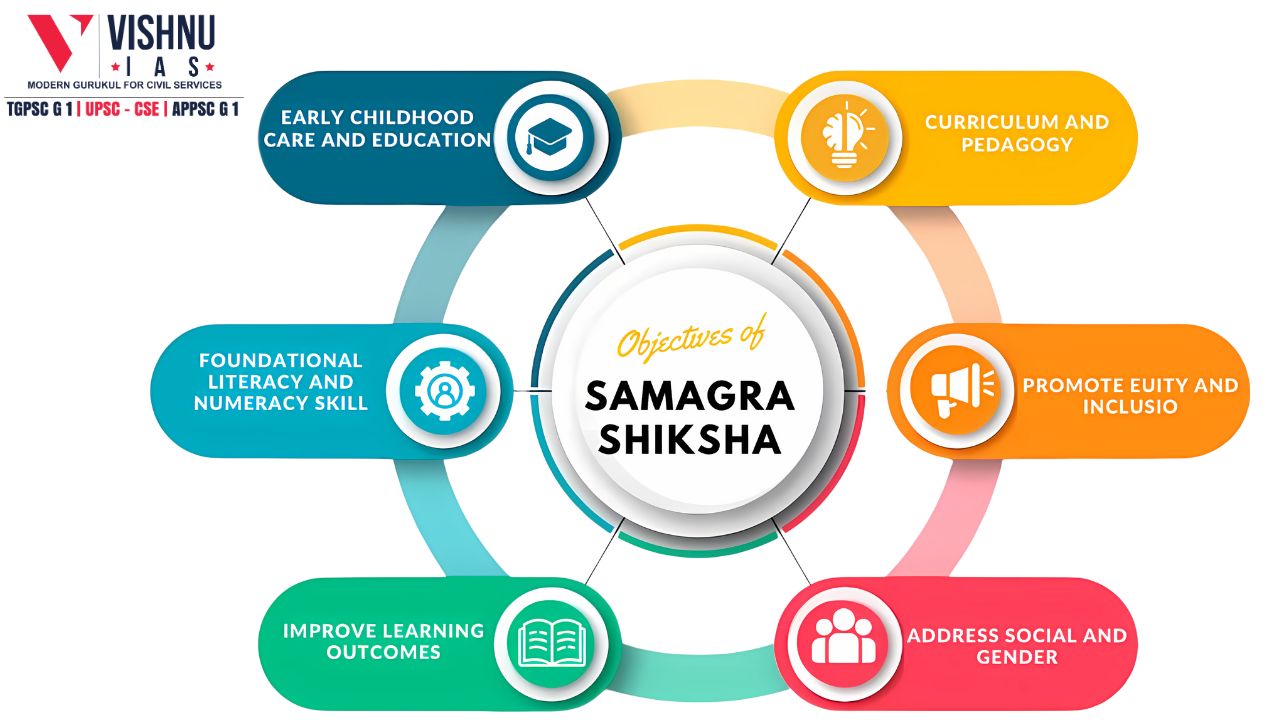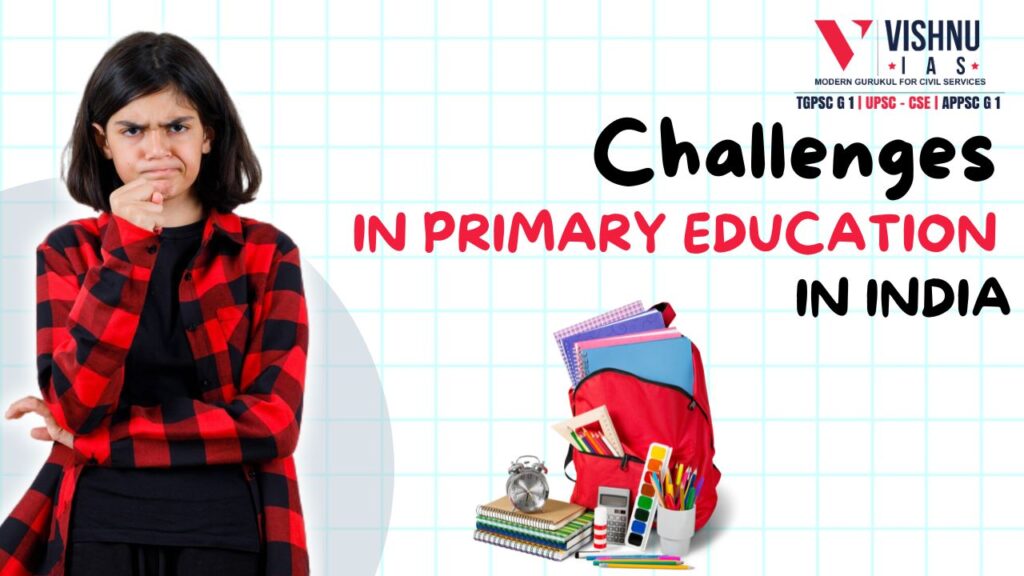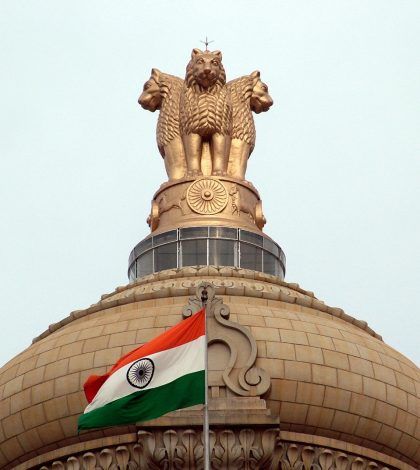Challenges in Primary Education in India
Primary education in India typically refers to the education provided to children between the ages of 6 and 14. Primary education in India is governed by both the central and state governments, with states having autonomy to frame their respective policies and curricula.
The Right to Education Act (RTE) of 2009 made education a fundamental right for every child between the ages of 6 and 14. The act mandates that all children receive free and compulsory primary education, regardless of their socio-economic background.
Status of Primary education:
- Gross Enrolment Ratio (GER): According to the Ministry of Education, India’s GER for primary education (Classes 1-5) has surpassed 100%. This signifies a near-universal push to get children into schools. In contrast, data from the National Sample Survey Organisation (NSSO) in the 1990s revealed a GER of around 80%, with a significant gender gap.
- Infrastructure Expansion: Government initiatives like Sarva Shiksha Abhiyan (SSA) have led to a substantial increase in schools. As per DISE (District Information System for Education) data, India has over 1.4 million schools at the primary level compared to around 6 lakh in the 1980s. This expansion has improved accessibility, particularly in rural areas.
- Focus on Equity: Schemes like the Mid-Day Meal Scheme, providing nutritious meals to students, have incentivized enrolment, particularly among disadvantaged groups.. Additionally, reservations for Scheduled Castes (SCs), Scheduled Tribes (STs), and Other Backward Classes (OBCs) aim to bridge the equity gap.
What are the challenges and issues of the primary education system in India?
The Enrolment Paradox: India boasts a Gross Enrolment Ratio (GER) exceeding 100% at the primary level, indicating a seemingly successful story in getting children into classrooms . However, this statistic masks a concerning reality – many enrolled children fail to translate enrollment into actual learning.
- The Annual Status of Education Report (ASER) 2022 paints a grim picture, revealing that only 50.3% of Class 5 students in rural India can read and comprehend a simple Class 2 text. This learning gap indicates deficiencies in the quality of education provided.
- According to the Annual Status of Education Report 2020, around 20% of rural schools in India have only one teacher for all grades, leading to inadequate attention and instruction to students.
- Data from the Unified District Information System for Education (UDISE) 2020-21 reveals that the national dropout rate for girls at the elementary level (Classes 1-8) is higher than for boys (10.1% compared to 7.1%). This perpetuates gender inequality and hinders the overall development of the nation.
- A 2018 report by the Comptroller and Auditor General of India (CAG) revealed that over 60% of schools lacked proper drinking water facilities. Such deficiencies create an unhygienic and uncomfortable learning environment, hindering student well-being and impacting their ability to focus.
- A study by NSO revealed that the percentage of children attending pre-primary schools was only 11.4% in rural areas, compared to 27.6% in urban areas.
- According to a 2018 report by Oxfam India, almost 40% of Indian children from marginalized communities are out of school.
- According to UNESCO’s 2020 Education for All Global Monitoring Report, the female literacy rate in India is 70.3%, while the male literacy rate is 84.7%.
- The Samagra Shiksha scheme, which is expected to be the major driver behind reversing learning losses, has registered a mere hike of 0.18%, with the allocation of Rs 37,453 crore in 2023-24.
What are the various government initiatives for primary and secondary education in India?
Samagra Shiksha
overarching programme for the school education sector which subsumes the three schemes of
- Sarva Shiksha Abhiyan (SSA)
- Rashtriya Madhyamik Shiksha Abhiyan (RMSA)
- Teacher Education (TE)
Objective: To support states and UTs in implementing the recommendations of the National Education Policy 2020 and Right of Children to Free and Compulsory Education (RTE) Act, 2009.

PM-POSHAN (Previously known as Mid-day Meals Scheme)
- Centrally Sponsored Scheme ‘Pradhan Mantri Poshan Shakti Nirman’ (PM POSHAN) is for providing one hot cooked meal in Government and Government-aided Schools.
- Beneficiaries: Children of pre-schools and the children of classes I to VIII.
Mahila Samakhya programme
- To empower rural women from socially and economically marginalized groups through education.
- Major beneficiaries: SC/ST women, women belonging to landless and marginalized families, who are engaged in wage labor.
Scheme for Providing Quality Education in Madrasas (SPQEM)
It seeks to bring about qualitative improvement in Madrasas to enable Muslim children to attain standards of the National education system in formal education subjects.
NIPUN Bharat (under Samagra Shiksha)
- National Initiative for Proficiency in Reading with Understanding and Numeracy (NIPUN Bharat) is launched to ensure that every child in the country. necessarily attains foundational literacy and numeracy (FLN) by the end of class 3 by 2026-27.
- It will focus on providing access to and retaining children in foundational years of schooling and teacher capacity building.
NISHTHA (under Samagra Shiksha)
- A capacity-building programme for “Improving Quality of School Education through Integrated Teacher Training”.
- Aim: To build competencies among all the teachers and school principals at the elementary stage through massive training programmes to encourage and foster critical thinking in students.
PM e-VIDYA
The scheme unifies all efforts related to digital/online/on-air education to enable coherent multi-mode access to education. The components are
- DIKSHA platform – ‘one nation-one digital education’
- Swayam Prabha TV channels
- Swayam – MOOCs platform for free E-Learning.
- Radio and community radio.
STARS Program
- The Government of India and the World Bank signed a $500 million Strengthening Teaching-Learning and Results for States Program (STARS) to improve the quality and governance of school education in six Indian states – Himachal Pradesh, Kerala, Madhya Pradesh, Maharashtra, Odisha, and Rajasthan.
- To be implemented as a new Centrally Sponsored Scheme under the Department of School Education and Literacy (DoSEL).
- Envisions to improve the overall monitoring and measurement activities in the Indian school education system through interventions in selected states.
Schools under the Central Government
- There are 1,740 schools (Kendriya Vidyalayas 1,092, Jawahar Navodaya Vidyalayas 586, and Central Tibetan Schools 62) with an enrollment of about 13 lakh students.
Institution:
National Council of Education Research and Training (NCERT): The GoI established the NCERT to assist and advise the Central and State governments on policies and programmes for qualitative improvement in school education.
Legal Provisions
Right to Free and Compulsory Education Act, 2009:
- Free and compulsory education to all Indian children between 6 to 14 age groups. “Compulsory” here means the government must provide free elementary education and ensure compulsory admission, attendance and completion of elementary education to all Indian children.
- The non-admitted child must be admitted to an age-appropriate class.
- As per the Act, the government schools must provide free education to all children and they are managed by School Management Committees (SMCs).
- The private schools are to admit at least 25% of the children in their schools without a fee.
- This Act mandates a 25% reservation for the disadvantaged sections of the society that includes the SC and STs, Socially Backward Class and differently abled.
- The standards like Pupil-Teacher Ratios (PTRs), buildings and infrastructure, schools’ working days, teacher’s working hours, qualifications and training of the teachers are defined under this Act.
- The deployment of teachers is rationalised so that there is no urban-rural imbalance.
- It prohibits the deployment of teachers for non-educational works, other than services like decennial census, elections, and disaster reliefs.
- It prohibits physical punishment and mental harassment, screen procedures for students’ admission, capitation fee, private tuition by teachers and running of non-recognized schools.
- This Act also states that the financial and other responsibilities should be shared between the Centre and state governments.
- It aims to make child free of fear, trauma and anxiety through a system of child-friendly and child-centred learning.
- The Right of Children to Free and Compulsory Education (Amendment) Act, 2019 removed the clause for “No Detention Policy”.
Way forward:
- Better training of Teachers: Training teachers effectively can lead to a better quality of education in schools by equipping them with updated knowledge, skills, and pedagogical strategies, which can enhance their teaching practices and ultimately benefit students’ learning outcomes.
- Introduction of technology: Technology has the potential to enhance the quality of education by providing students with innovative tools and resources that can help them learn more effectively and efficiently.
- Decentralization and greater local autonomy: Decentralizing school management to local authorities and school boards with parent representation ensures accountability and improves daily functioning.
- Planning for school infrastructure: Ensuring adequate land for schools is crucial. Urban planning and local development plans must consider the physical needs of schools, including playgrounds and facilities.
- Reforms in the curriculum and examination system: Curriculum reform is crucial in improving education, making it more relevant and focusing on comprehension, communication, and independent knowledge access instead of rote learning.
- Special focus on disadvantaged groups: Such as girls, SCs, STs, religious minorities, wards of migrants, working children, and differently-abled, to make sure


